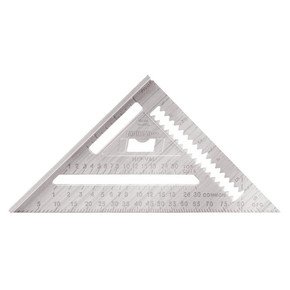

As a saw guide, stair layout tool or rafter tool, Johnson's rafter square will help you get the job done accurately and easily. Its solid aluminum body construction with CNC machined edges provides greater accuracy along with durable chip-resistant coating. Use the scribe notches for marking and ripping lumber and handy markers that measure 2x4 board dimensions of 1-1/2", 3" and 3-1/2". This square also has deep cast-in graduations that will never peel off, wear off, fade or smudge.
This Johnny Square is a versatile tool for builders and contractors. Its thick edge is useful as a saw guide - it can be used directly with the saw against the square for cross cuts or angled cuts using the etched protractor scale. It can be used indirectly as well, using the scribing notches to create a saw cut line for rip cuts. The Johnny Square also simplifies stair layout - its integrated distance and angle scales let you quickly and accurately mark your cut lines on your stringers. And, of course, this rafter square has scales for cutting hip, valley and jack rafters.
As a saw guide, stair layout tool or rafter tool, Johnson's rafter square will help you get the job done accurately and easily. Its solid aluminum body construction with CNC machined edges provides greater accuracy along with durable chip-resistant coating. Use the scribe notches for marking and ripping lumber and handy markers that measure 2x4 board dimensions of 1-1/2", 3" and 3-1/2". This square also has deep cast-in graduations that will never peel off, wear off, fade or smudge.
This Johnny Square is a versatile tool for builders and contractors. Its thick edge is useful as a saw guide - it can be used directly with the saw against the square for cross cuts or angled cuts using the etched protractor scale. It can be used indirectly as well, using the scribing notches to create a saw cut line for rip cuts. The Johnny Square also simplifies stair layout - its integrated distance and angle scales let you quickly and accurately mark your cut lines on your stringers. And, of course, this rafter square has scales for cutting hip, valley and jack rafters.